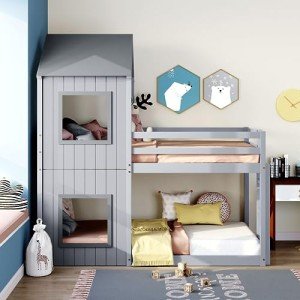The Ultimate Guide to Bunk Beds for Kids: Safety, Styles, and Solutions
Bunk beds have actually long been a popular choice among parents seeking to enhance space in their kids's bedrooms. With benefits that surpass their compact design, bunk beds provide a fun and practical sleeping arrangement while encouraging sibling bonding and cultivating imagination. In this comprehensive guide, we check out various elements of bunk beds for kids, consisting of security considerations, various designs offered, and suggestions for selecting the right one for your household.
Why Choose Bunk Beds?
Bunk beds are created to stack one bed on top of another, utilizing vertical space to produce more room for play and storage. They are especially beneficial for households with multiple children or minimal bed room space. Additionally, they supply an adventurous sleeping environment that kids typically enjoy.
Secret Advantages of Bunk Beds:
- Space-saving design: Ideal for little rooms or shared spaces.
- Cost-efficient: Often more cost effective than purchasing 2 separate beds.
- Encourages social interaction: Promotes bonding among brother or sisters or good friends.
- Flexible choices: Available in different styles and configurations to match any room design.
Security First: Essential Considerations
When choosing a bunk bed for kids, safety needs to be the top concern. The following features are crucial for making sure a safe and secure sleeping environment:
Important Safety Features:
- Sturdy Construction: Ensure that the bed frame is made of long lasting materials such as solid wood or metal.
- Guardrails: Bunk beds ought to have guardrails on both sides of the upper bunk to prevent falls.
- Ladder Safety: A sturdy, built-in ladder or stairs with anti-slip rungs is vital for safe access to the top bunk.
- Weight Limit: Check the producer's weight limit capability for both the top and bottom bunk.
- Bed mattress Size: Use the correct bed mattress size as defined by the bed manufacturer to make sure a tight fit within the bed frame.
Safety Tips for Parents:
- Monitor Sleep Habits: Teach children the significance of not using or leaping off the bunk beds.
- Age Appropriateness: Generally, the upper bunk is appropriate for kids aged 6 and older.
- Regular Inspections: Periodically examine for any loose bolts, screws, or structural damage.
Designs of Bunk Beds
Bunk beds can be found in a variety of styles, permitting parents to select one that matches their child's space decoration while conference particular requirements. Below are some popular designs:
Popular Bunk Bed Styles:
- Traditional Bunk Beds: Simple and traditional designs made from wood or metal without any extra features.
- Loft Beds: Features a raised top bunk with space below for a desk, play area, or extra storage.
- L-Shaped Bunk Beds: Arranged in an L-shape, often ideal for corner spaces and can have additional storage alternatives.
- Twin over Full Bunk Beds: A twin bed on top and a bigger full-sized bed on the bottom, accommodating children or teens of various ages.
- Triple Bunk Beds: Designed to fit three beds in a single footprint, perfect for bigger families or slumber parties.
A Comparison of Bunk Bed Styles
| Bunk Bed Style | Description | Best For |
|---|---|---|
| Traditional | Classic style with 2 stacked beds | Standard bed room setups |
| Loft Bed | Raised bed with usable space beneath | Homework or play locations |
| L-Shaped | Bunk beds arranged in an L-shape | Corner areas |
| Twin over Full | Twin bed on top, full bed below | Different age brother or sisters |
| Triple Bunk | Three stacked beds | Large households or pajama parties |
Picking the Right Bunk Bed
When searching for the ideal bunk bed, think about the following elements to ensure you make an informed decision:
Key Factors to Consider:
- Room Size: Measure the room measurements to figure out the suitable size and height of the bunk bed.
- Child's Age: Consider the age of your kid(ren) when choosing a style and security features.
- Performance: Think about just how much storage or play space you require and whether the bunk bed need to serve extra purposes.
- Budget plan: Set a spending plan that includes not just the bunk bed however likewise the required bed mattress and accessories like bedding or security gates.
FAQs About Bunk Beds for Kids
1. What age is appropriate for a child to oversleep the top bunk?
Typically, children aged 6 and older ought to be able to securely sleep in the top bunk, though you need to always consider your kid's maturity level.
2. Are bunk beds safe for toddlers?
It is not suggested for young children or extremely children to oversleep the top bunk due to the threat of falling.
3. How do I keep the bunk bed?
Examine the bed frequently for any signs of wear and tear, tightening screws, and cleaning the mattresses to ensure prolonged security and resilience.
4. Can I convert a bunk bed into 2 separate beds?
Lots of bunk beds are created to be convertible, enabling you to separate the beds when required. Examine the maker's specs before purchasing.
5. How can www.bunkbedsstore.top in a bunk bed space?
Use under-bed drawers, racks, or lofted styles to produce extra storage solutions in a space with a bunk bed.
Bunk beds use a delightful mix of enjoyable, functionality, and space-saving utility, making them an ideal choice for young families. By considering safety features, various styles, and practical factors such as room size and age suitability, parents can pick the perfect bunk bed for their child's needs. With the ideal choice, bunk beds can change a bedroom into a magical space that motivates play, imagination, and bonding amongst brother or sisters. Always keep in mind to prioritize safety and upkeep to make the most of this unique sleeping arrangement.

